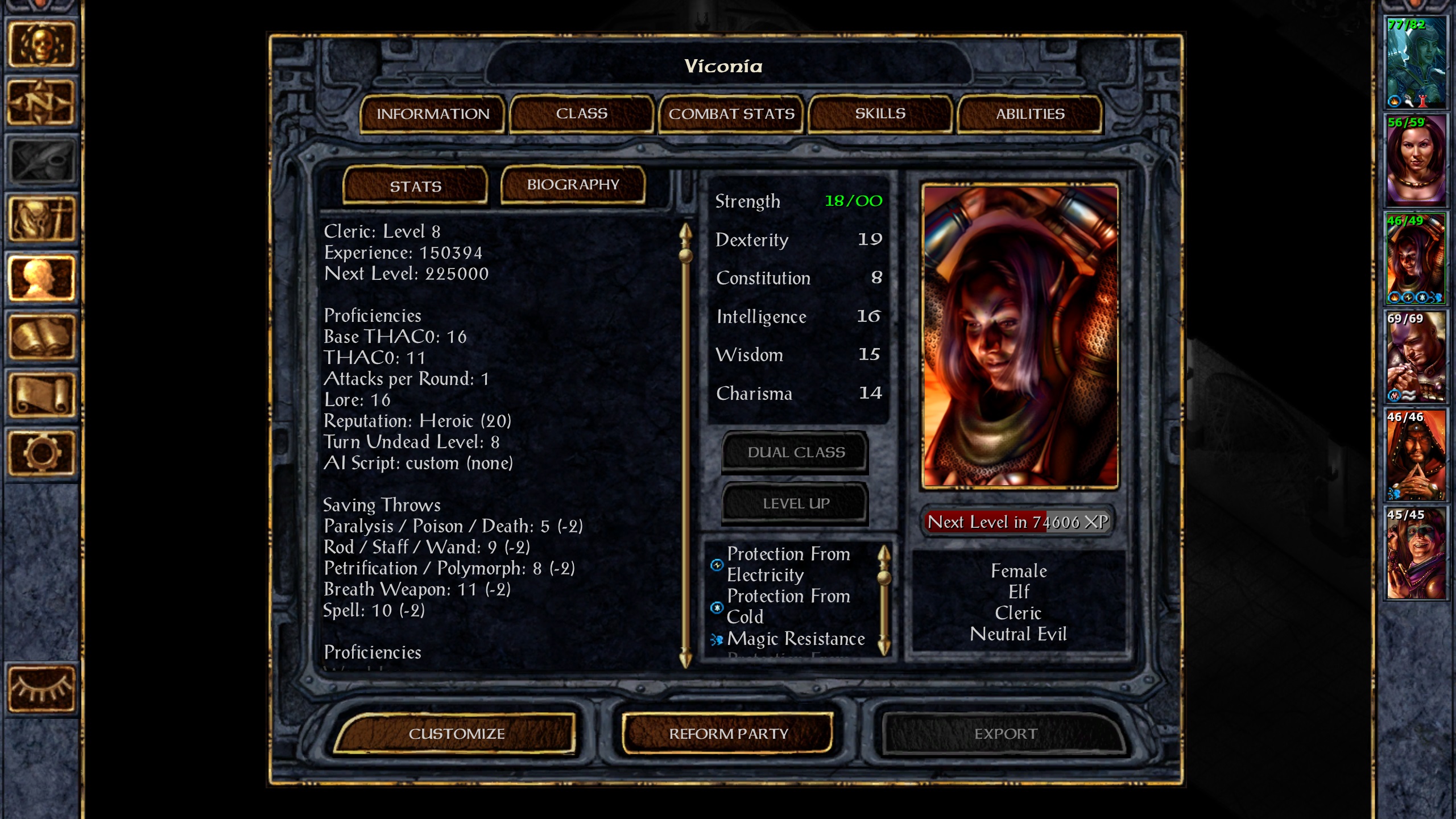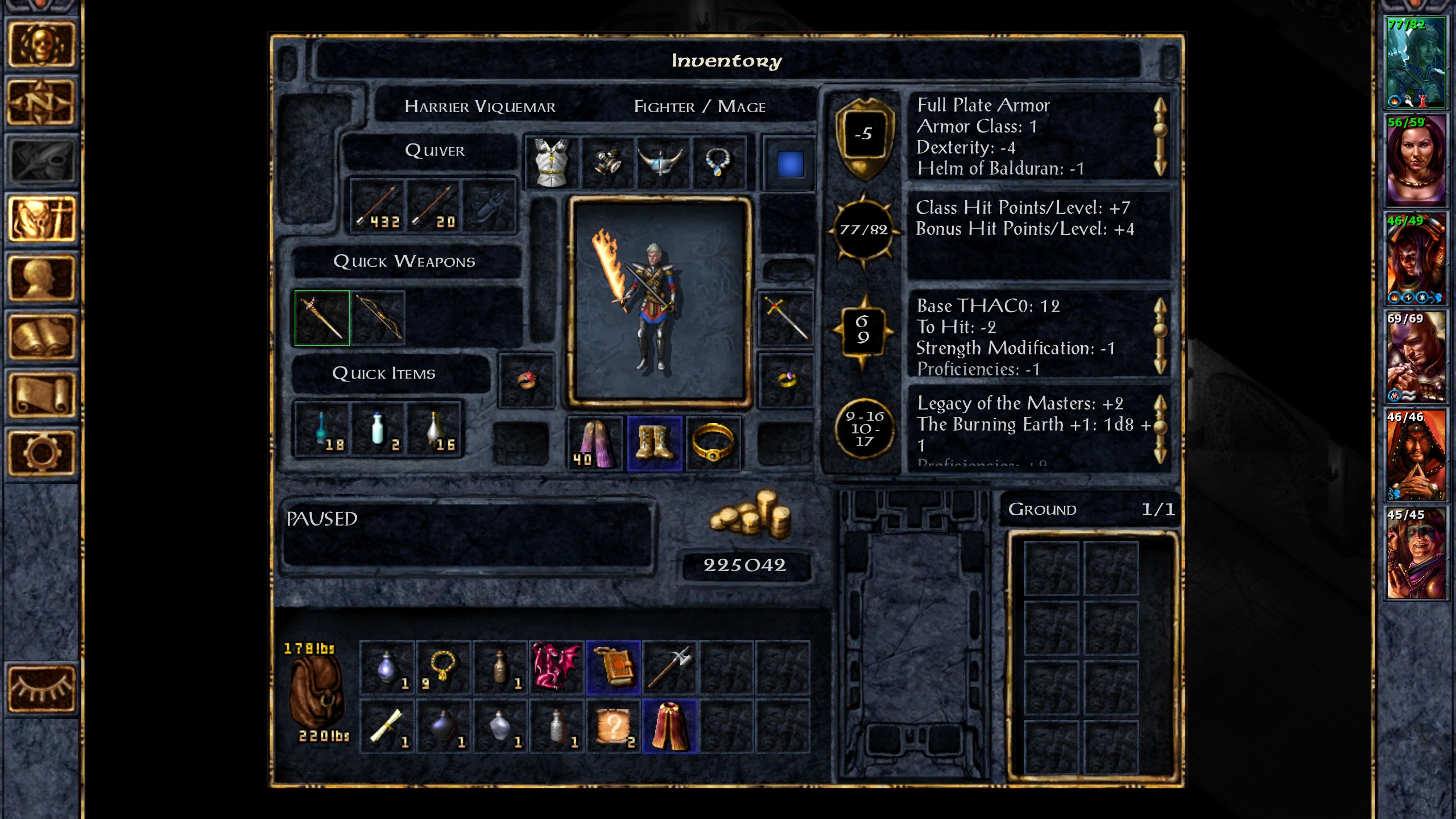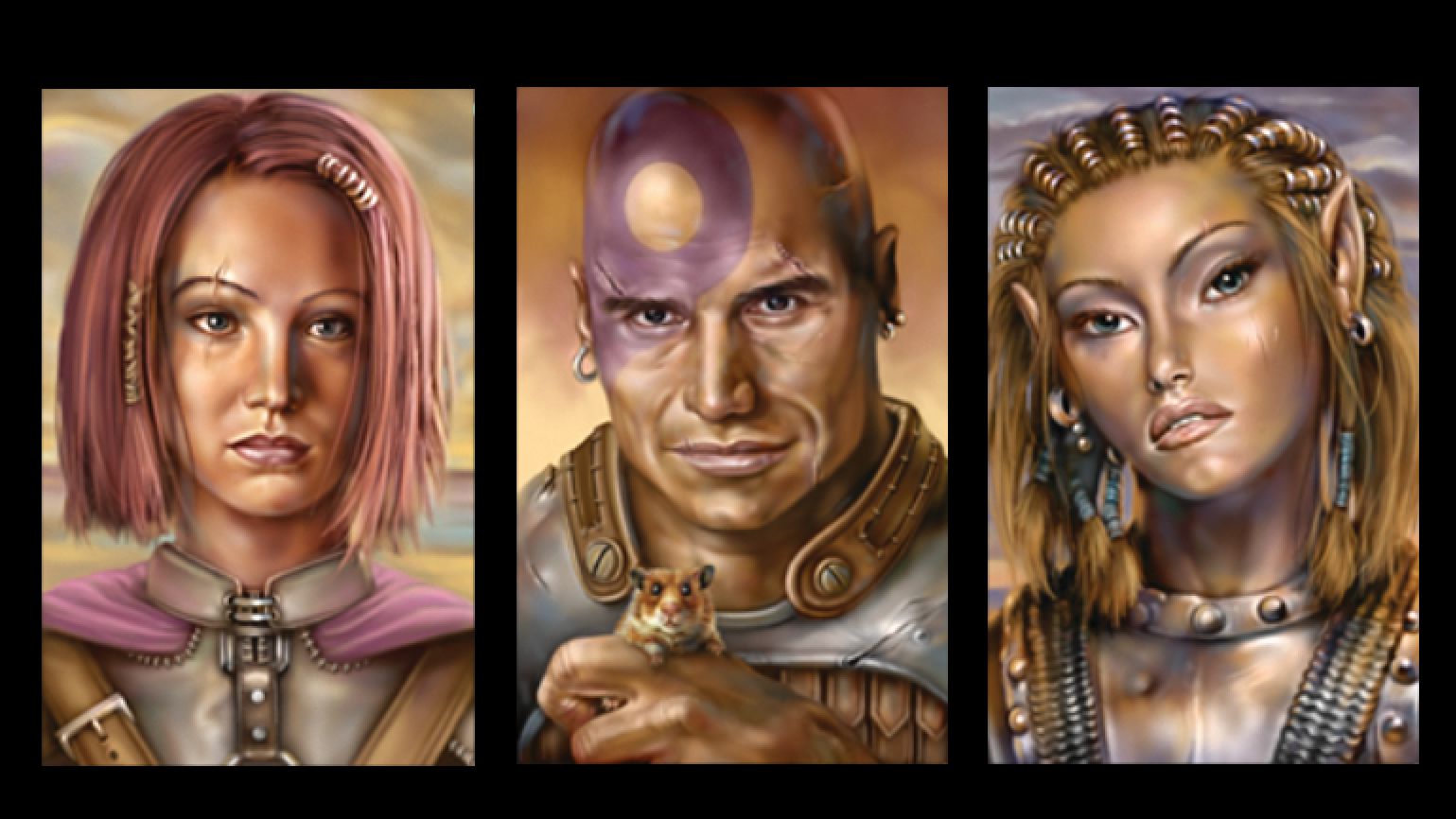So you've beaten Baldur's Gate 3 and want to get into the original games—here's how, from a longtime Baldur's Gate freak
What the heck's a THAC0? I'm so glad you asked!

If Baldur's Gate 3 was your introduction to the Baldur's Gate series or even CRPGs in general, good news: The first two games are absolutely playable today, and although they're very different—they're over two decades old, for one thing—you can find a lot to love in them, including some characters you've already met. Here's how to play Baldur's Gate 1 and 2, including which versions to get and mods to use, and what you should know going into them from Baldur's Gate 3.
Differences between the original Baldur's Gates and BG3
A lot has changed in RPGs since Baldur's Gate 1 dropped in 1998, and the first thing you'll notice is feedback and presentation. I love the original games' 2D, pre-rendered look, and I think it's aged well, but the OG Baldur's Gates are definitely harder to parse than BG3 or even BioWare's immediate successor RPGs.
Tooltips, area of effect indicators, and other player comfort features are much more limited, and you'll have to find your own rhythm micromanaging your party with the original games' real time with pause combat—you can pause the action to issue orders, but otherwise characters act more like RTS units—if you're coming in acclimated to Larian's turn-based systems. The lack of tooltips or explainers means online guides or the handy manual PDF that comes with the Enhanced Editions are a must.

Baldur's Gate 3 guide: Everything you need
Baldur's Gate 3 tips: Be prepared
Baldur's Gate 3 classes: Which to choose
Baldur's Gate 3 multiclass builds: Coolest combos
Baldur's Gate 3 romance: Who to pursue
Baldur's Gate 3 co-op: How multiplayer works
The original games don't have that same intricate reactivity as Baldur's Gate 3—you make some quest choices, but in terms of your character's build and skills affecting dialogue or having huge world state changes like siding with the Grove or Goblins, you'll find more of that in other turn of the millennium contemporaries like Fallout, Planescape: Torment, or Arcanum: of Steamworks and Magick Obscura. BG2 does, notably, have a sick player stronghold that depends on what class you are: Fighters get a castle, while Bards manage a theater.
There's still a ton of continuity here. All three games share a similar Forgotten Realms swashbuckling vibe, and carry that fantasy of crafting your own hero traveling with a cast of lovable characters. What's more, the original games' character building, devilish encounter design, and extensive list of genuinely transformative magical artifacts to equip your characters with will definitely be familiar to BG3 players. The spellcasting system is a real treat as well—all three Baldur's Gates are some of the best wizard games out there, and even if you have a martial main character, you'll want to pay special attention to your spellcasters and their capabilities.
What versions of Baldur's Gate 1 and 2 should I play?
Go with Beamdog's Enhanced Editions all the way. I'm glad the OGs are still available on GOG (with purchase of the EEs) for preservation's sake, and there are some quirks of the very original Baldur's Gate that get sanded off on transition to a unified system based off Baldur's Gate 2—I know there are at least a few BG1 purists out there.

But for a newcomer, the Enhanced Editions' quality of life changes and unified rulest can't be beat. Most major mods for the originals still function with, or have been updated for the Enhanced Editions. Also, and this almost feels blasphemous to say, the console and tablet/smartphone ports are really excellent. I still prefer mouse and keyboard here, but I was able to beat the entire original duology on Nintendo Switch with Joy Con controls.
Keep up to date with the most important stories and the best deals, as picked by the PC Gamer team.
What about companions and romances?
Both games feature charismatic, winning casts, but BG1 has a wide array of less developed companions to bring into your six-person party, while BG2 has a smaller, but more fleshed out crew. BG1 doesn't really have romance subplots or even many in-depth companion side quests, while BG2 really feels like the birthplace of that "BioWare Formula"—romances, loyalty quests, interjections during story moments, the works.
However, BG2 is very limited when it comes to romanceable men (just some loser named Anomen) or queer romance options. The Enhanced Editions expand this with their own new companion additions, but you'll have to turn to mods if you want the original cast to loosen up a little (or if you want to date cranky Thayan Mage Edwin). Also of note: BG2's romanceable NPCs are, by default, limited by what race your character is, and the Baldur's Gate Wiki has a good breakdown of those restrictions.

There's no party camp or experience sharing in either game. With the exception of rounding out your party in the early game or dipping into some of BG2's companion quests, you'll want to limit yourself to the same five buds for the whole adventure. Some companions also get testy depending on your choices, while certain party compositions inevitably lead to violence due to their members' contrasting worldviews (think Lae'zel vs Shadowheart, but with no persuasion option).
A quick rules breakdown (no really, what's THAC0??)
"To Hit AC 0," or "THAC0," is a measure of how easy it is for you to land a hit on an enemy in AD&D and, by extension, Baldur's Gate.
AC still stands for "Armor Class" here like it does in D&D5E and Baldur's Gate 3. In Baldur's Gate 3, you want your character to have a high armor class, because it's the number enemies have to match or beat with their attack roles to hit. In AD&D, however, a lower (even negative) AC is better.
Each character has a THAC0, which is the d20 roll they have to make to land a hit on an AC of 0. If my THAC0 were 10, I'd have to roll a 10 to hit someone with a 0 AC. If their AC were 1, I'd only have to roll a 9. And in the other direction, if their AC were -1, I'd have to roll an 11.
If you've heard of "JRPG Bullshit," this is "CRPG Bullshit" and I both love and hate it in equal measure. Other big AD&D differences:
- Clerics and Sorcerers get new spells on leveling up, while Mages (Wizards) just get spell slots and must learn new spells from scrolls.
- You put proficiency points in specific weapons and weapon styles, and proficiency is key to hitting enemies with any consistency—you want to limit yourself to weapons you have proficiency in and specialize in them. Greatswords, longswords, longbows and flails are great options.
- There are many more hard crowd control and instant death effects to watch out for. Make sure your arcane spellcaster knows "Protection From Petrification" to deal with all the jerk instakill Basilisks in Baldur's Gate 1.
- There are more racial, class, and gear restrictions broadly (unless you mod them out). Only humans can be Paladins, and arcane spellcasting can't be performed while wearing most armor, even with proficiency in that armor.
- Less AD&D, and more Baldur's Gate: Quicksave even more often than you would in BG3! There aren't many autosaves at all in the originals.
What sort of character should you make first?
A straight Sorcerer or Mage is very fun, and again, no matter who your main character is you'll want at least one well-catered to arcane spellcaster in a party. I'm broadly anti-Fighter, but they're fine, I guess. The Paladin's Cavalier subclass is a real easy-to-recommend first time option. Just like in BG3, Paladin gives you the approachability of a guy with a big sword while still introducing more complicated systems and encouraging roleplaying.

No matter what your class, attributes are a bit different and more obtuse in this version of D&D. After character creation, you can only improve them through items or story events, and instead of a set number of points to assign, the game "rolls" a point pool for you. You can re-roll your attribute pool as many times as you want in character creation, and I refuse to step out the door with less than 85 points total, 90+ preferred. You can get a mod to guarantee a good roll, but I like to just put a podcast on and get clicking.
18 in a stat is generally the highest it'll go, but Elves can hit 19 Dexterity, Dwarves 19 Constitution, and Half-Orcs both 19 Strength and Con. Strength (and only Strength) also has subdivisions between 18 and 19, represented as "18/00." The second number is a percentage calculated entirely in the background at character creation and affects your overall damage and THAC0. All these years later and I both barely understand, and fully resent this weird little mechanic.
Intelligence and Wisdom are still in-demand from Mages and Clerics respectively, while all melee characters will want max Strength—there's no Finesse mechanic in these games for sneaky types. 18 in Dexterity and Constitution is great on any character, especially Dexterity, which gives you a big bonus to AC even if you're wearing heavy armor. Charisma can unlock a few dialogue options, but crucially is not tied to Sorcerer spellcasting—Sorcerers' spells are just good, no matter what their stats are.

Multiclassing isn't too complicated, and is doable on a first character. In Baldur's Gate, you select a multiclass at character creation and gain experience in two or more classes simultaneously—a Fighter/Mage will progress in both disciplines slower, but will have that added versatility (Stoneskin and Haste, baby) while still progressing their HP and THAC0 at a comparable rate. The triple multiclasses should be reserved for lone wolf playthroughs due to experience point limitations—you'll only reach high levels as a Fighter/Mage/Thief if you don't have to share with companions.
Multiclassing, then, is very good, but there's another way to have two classes on the same character: Dual Classing. I hate Baldur's Gate's Dual Class system with every fiber of my being—it lets human characters switch to a second class permanently later in the game, but they lose all the powers of their first class until they hit an experience threshold dependent on their investment in that first class.
You basically make yourself into Magikarp for a while in order to have a late-game build of questionable superiority to a regular multiclass, but on paper Dual Classing allegedly is stronger, eventually. For my money, it's D&D powergaming at its worst—hardcore forum guys love Dual Classing, but I just find it obtuse.
Some top mods
I am a huge fan of the Gibberlings3 Tweaks Anthology, which offers everything from quality of life fixes and tabletop-accurate adjustments to full-on cheats. My essentials are the removal of racial and gender restrictions from classes, kits, and romances, as well as infinite inventory stacking of ammunition and other items. The same .exe will work in the respective file of the Infinity Engine game you want to modify, and it operates through a simple step-by-step command line interface.
BioWare veteran David Gaider's own Ascension mod is another you might consider as a first time player. It increases the difficulty of endgame fights in BG2's expansion, Throne of Bhaal, but also rewrites certain portions of the story as well as some companion epilogues.

Sword Coast Stratagems is a great mod, but not necessarily one for a first timer. It increases the games' difficulty well beyond what was originally intended, primarily by making the AI that much cannier and more ruthless. Definitely one I'd save for a replay.
Guides & resources
Baldur's Gate has a good Fandom wiki for any quick hits, but I'd highly recommend Mike's RPG Center, Gamebanshee, and Lilura1's CRPG blog for more in depth needs.
In particular, Mike's has a great, clean directory of all the weapons and armor in BG1 and 2, Gamebanshee has solid, area-by-area walkthroughs of both games, and Lilura1's blog has handy class builds, top item picks, as well as an essential list of all arcane spells in both games and which you should pick per level.
Custom portraits

Mike Sass' character artwork for Baldur's Gate is iconic, but sometimes you just want something special for yourself—I've often imported his later work from Neverwinter Nights to use in Baldur's Gate. The Baldur's Gate Wiki has a handy guide to what proportions your images need and where to save them for custom in-game portraits.
Consider changing this one setting
Under Gameplay: Feedback, there's an option called "Disable Cosmetic Attacks." This makes it so that your character will only perform an attack animation when it's their turn to attack. Otherwise, they kind of just loop through attack animations to make fights more visually interesting, with the game's combat log keeping the score.
I found going without cosmetic attacks just helps the game feel a little better (am I just missing all these attacks while my guy flails around?), and also clear up a little bit of that feedback gap I mentioned at the beginning of the article.
Ted has been thinking about PC games and bothering anyone who would listen with his thoughts on them ever since he booted up his sister's copy of Neverwinter Nights on the family computer. He is obsessed with all things CRPG and CRPG-adjacent, but has also covered esports, modding, and rare game collecting. When he's not playing or writing about games, you can find Ted lifting weights on his back porch.

